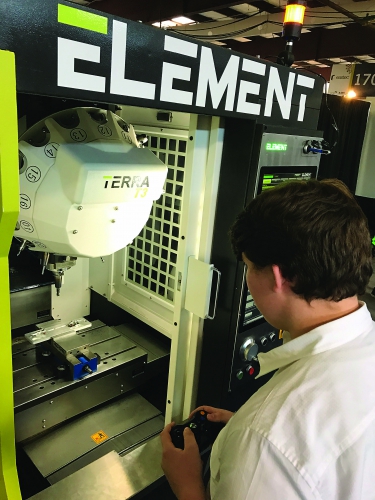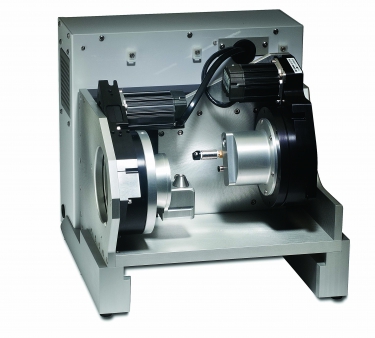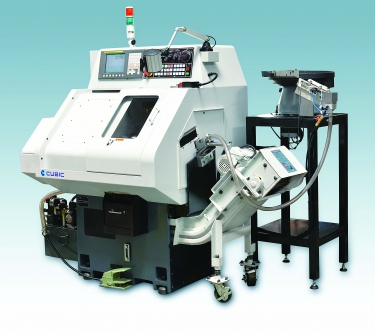There’s little that can’t be made with today’s standard CNC machine tools. They’re fast, accurate and powerful.
But every so often a job or part geometry comes along where a few extra inches in a machine’s work envelope would be helpful. Or perhaps a little higher rpm or an additional spindle are all that’s needed to make a job profitable.
At these and certain other times, it might be worth considering a custom machine.
It’s Elemental
Ben Brown, vice president of sales and marketing at Element Machine Tools Inc., offers several reasons why a custom CNC machine is often a better solution than a stock machine. “Our customers can take an à la carte approach to machine selection. They can pick whatever technology is most important to them, and we’ll design the machine accordingly,” he said. Customers can avoid having to buy a machine that costs considerably more money with options they don’t particularly need or care about, Brown added.

Equipping machines with Xbox-style controllers might be a great way to get young people interested in machining. Image courtey of Element Machine Tools.
One common modification is the ballscrew. A “fast-pitch” screw greatly increases rapid-traverse speeds but sacrifices power and torque, whereas a screw with a fine pitch provides just the opposite. Glass scales for high-precision work are also available, as are extended machine travels and any number of control modifications to enhance efficiency.
Brown cited an example of Element Machine’s control-modifying capabilities. The Lebanon, Maine, company is working with a manufacturer that needs custom software for a machine control. “We’re providing a very simple user interface that allows the machine operator to punch in the key features of the part and have the control generate the G code,” Brown said. “Features like this make it possible for even less-experienced operators to create programs on the fly.”

Automation accounts for roughly 70 percent of the custom machine orders at Cubic Machinery. Image courtesy of Cubic Machinery.
Brown’s task is made easier because Element designed the control. The PC-based Carbon-series CNC has an API (application programming interface) based on Lua, an open-source scripting language that makes it easy to modify the control interface. Because of this capability, virtually every control that leaves Element has been customized in some way, whether it’s the screens installed, database read/write capability or integration of third-party software, eliminating the need for an additional—and often expensive—interface.
Element also builds “off-the-shelf” equipment, including several models of CNC lathes, knee mills and machining centers. Any of these might be used as-is or converted into a special, reducing the lead time and development costs compared to building from scratch.
“We recently codeveloped a machine for a customer that wanted to produce baseball bats in very high volumes,” Brown said. “We modified one of our lathes with an autoloader, and added double blades for cutting each side of the bat simultaneously, a sanding system and customized control.” The customer can load raw stock and produce a finished bat in one operation, reducing the total manufacturing time by about 40 percent, Brown noted.
Preparing for a New Era
Autoloaders and other types of automated material-handling systems are a common addition to many machine tools.
Joe Lin, president of Chino, Calif.-based Cubic Machinery Inc., said adding automation accounts for roughly 70 percent of the company’s custom work. Many of his customers are seeing work come back from China, but the market remains very competitive, especially in California, where wages are high, he added.
“That’s why a lot of people want to automate their machine tools,” Lin said. “For example, we might mount a PLC on one of our gang-style machines and equip it with a parts loader and a mechanism for flipping the part. Sometimes we’ll equip a machine with a vision system for in-process measurement or integrate a 6-axis robot into an unattended machining cell.”
Lin added that customization—whatever form it takes—adds value to the machine tool while reducing operational costs.
One example is Cubic Machinery’s TS-1000, a machine for producing high volumes of aerospace fasteners. Lin said most of the screws, bolts and pins used in the aerospace industry are produced on cold-heading machines, which often produce part features insufficiently accurate for aerospace work or require modification. Typical operations include grooving, burnishing, cross-hole drilling, pointing and slotting. By equipping one of Cubic’s standard machines with a load/unload mechanism, together with whatever auxiliary machining head is needed to modify the part, manufacturers can produce thousands of accurate custom fasteners daily in untended operations.

Motion control provider Bell-Everman designed and built this custom dental-implant milling machine for one of its customers. Image courtesy of Bell-Everman.
How do you go about ordering a custom machine? Lin said it’s not difficult. “Most of our systems are turnkey. The customer comes to us with the part requirements, and we’ll design the process to match. We create an animation to show the customer how the part will be processed, and, once they agree, we take a down payment and get to work.”
Before delivering a machine to a customer, Cubic has a runoff in its facility to verify everything is working properly. If the customer can’t attend, Cubic sends a video of the operation. Then it ships the machine, installs it and trains the users. According to Lin, the entire process takes 3 to 6 months.
Setting the Stage
Just up the coast from Cubic Machinery sits another custom machine tool provider and automation integrator, Bell-Everman Inc., Goleta, Calif. President Tom Maccianti said the company started as a provider of linear and rotary stages for the semiconductor industry, but increasingly found itself designing and building custom automation systems and subsystems. One of these systems was for a tabletop milling machine for a dental-products provider.
Maccianti explained that the customer had recently acquired an intraoral scanning company and wanted to complement its product line with a dental-implant machining solution.
He said: “Rather than design and build a traditional 3-axis, XYZ mill, we used two rotary tables and polar-coordinate positioning, as well as Delta Tau controls, to convert the G code into the right coordinates. One table held the workpiece and the other the spindle, which was mounted on a linear stage. It took just 18 minutes after pushing the green button to have a finished tooth, ready for implantation.”

Bowl feeders, load and unload accessories, and inline part inspection are just a few of the custom machine options available on CNC machines. Image courtesy of Cubic Machinery.
A machine to cut a new tooth might not seem relevant to those milling conventional parts all day, but the lessons learned from designing such a machine are.
Anyone shopping for custom CNC equipment should partner with an integrator that understands all aspects of machine tool technology, Maccianti said. As an example, he said when selling standard linear and rotary motion products, he finds numerous machine designers understand motion control, but know little about integrating it with a conveyor or which amplifier works best with a certain servomotor.
“You need somebody with well-rounded experience. Sometimes those companies are hard to find,” he said. “Also, we often learn during the discovery phase that what the customer wanted at the start of the project is not what they actually need. Without a good partner and a well-defined statement of work, it’s pretty easy to stub your toe.”
Contact Details
Related Glossary Terms
- burnishing
burnishing
Finishing method by means of compressing or cold-working the workpiece surface with carbide rollers called burnishing rolls or burnishers.
- centers
centers
Cone-shaped pins that support a workpiece by one or two ends during machining. The centers fit into holes drilled in the workpiece ends. Centers that turn with the workpiece are called “live” centers; those that do not are called “dead” centers.
- computer numerical control ( CNC)
computer numerical control ( CNC)
Microprocessor-based controller dedicated to a machine tool that permits the creation or modification of parts. Programmed numerical control activates the machine’s servos and spindle drives and controls the various machining operations. See DNC, direct numerical control; NC, numerical control.
- gang cutting ( milling)
gang cutting ( milling)
Machining with several cutters mounted on a single arbor, generally for simultaneous cutting.
- grooving
grooving
Machining grooves and shallow channels. Example: grooving ball-bearing raceways. Typically performed by tools that are capable of light cuts at high feed rates. Imparts high-quality finish.
- milling
milling
Machining operation in which metal or other material is removed by applying power to a rotating cutter. In vertical milling, the cutting tool is mounted vertically on the spindle. In horizontal milling, the cutting tool is mounted horizontally, either directly on the spindle or on an arbor. Horizontal milling is further broken down into conventional milling, where the cutter rotates opposite the direction of feed, or “up” into the workpiece; and climb milling, where the cutter rotates in the direction of feed, or “down” into the workpiece. Milling operations include plane or surface milling, endmilling, facemilling, angle milling, form milling and profiling.
- milling machine ( mill)
milling machine ( mill)
Runs endmills and arbor-mounted milling cutters. Features include a head with a spindle that drives the cutters; a column, knee and table that provide motion in the three Cartesian axes; and a base that supports the components and houses the cutting-fluid pump and reservoir. The work is mounted on the table and fed into the rotating cutter or endmill to accomplish the milling steps; vertical milling machines also feed endmills into the work by means of a spindle-mounted quill. Models range from small manual machines to big bed-type and duplex mills. All take one of three basic forms: vertical, horizontal or convertible horizontal/vertical. Vertical machines may be knee-type (the table is mounted on a knee that can be elevated) or bed-type (the table is securely supported and only moves horizontally). In general, horizontal machines are bigger and more powerful, while vertical machines are lighter but more versatile and easier to set up and operate.
- milling machine ( mill)2
milling machine ( mill)
Runs endmills and arbor-mounted milling cutters. Features include a head with a spindle that drives the cutters; a column, knee and table that provide motion in the three Cartesian axes; and a base that supports the components and houses the cutting-fluid pump and reservoir. The work is mounted on the table and fed into the rotating cutter or endmill to accomplish the milling steps; vertical milling machines also feed endmills into the work by means of a spindle-mounted quill. Models range from small manual machines to big bed-type and duplex mills. All take one of three basic forms: vertical, horizontal or convertible horizontal/vertical. Vertical machines may be knee-type (the table is mounted on a knee that can be elevated) or bed-type (the table is securely supported and only moves horizontally). In general, horizontal machines are bigger and more powerful, while vertical machines are lighter but more versatile and easier to set up and operate.
- pitch
pitch
1. On a saw blade, the number of teeth per inch. 2. In threading, the number of threads per inch.
- slotting
slotting
Machining, normally milling, that creates slots, grooves and similar recesses in workpieces, including T-slots and dovetails.
- vision system
vision system
System in which information is extracted from visual sensors to allow machines to react to changes in the manufacturing process.
- work envelope
work envelope
Cube, sphere, cylinder or other physical space within which the cutting tool is capable of reaching.
Contributors
Bell-Everman Inc.
(805) 685-1029
www.bell-everman.com
Cubic Machinery Inc.
(909) 590-9995
www.cubicmachinery.com
Element Machine Tools Inc.
(207) 860-7226
www.element-cnc.com
Hydromat Inc.
(314) 432-4644
www.hydromat.com








